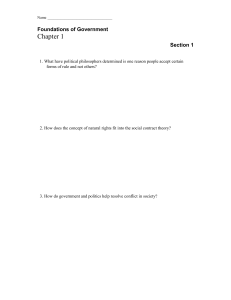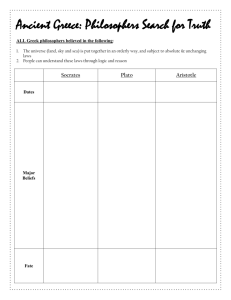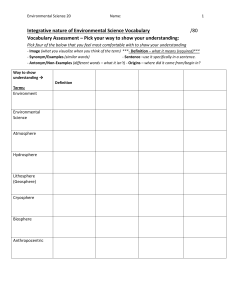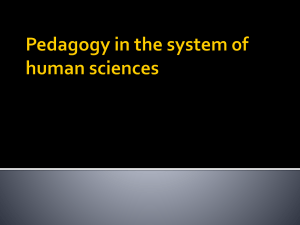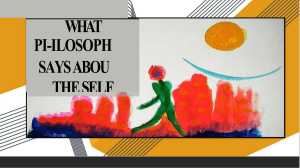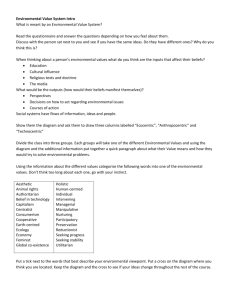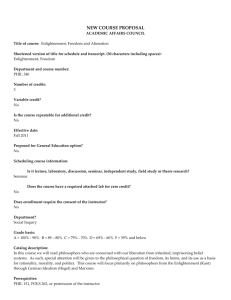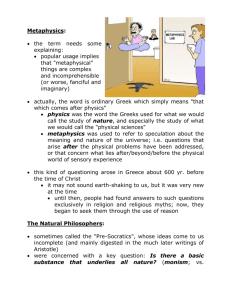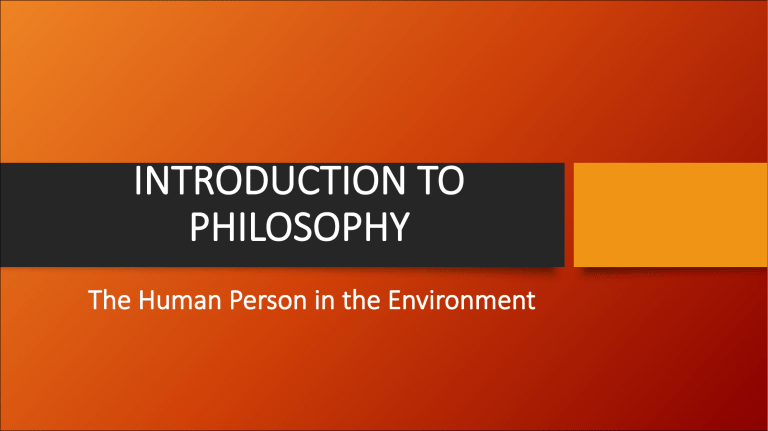
INTRODUCTION TO PHILOSOPHY The Human Person in the Environment Objectives • To probe into a distinct frame about gaining valuable insights regarding the human person in the environment • To demonstrate the virtues of prudence and frugality toward his/her environment • Appreciate the beauty of nature Introduction “What is the world made of?”,” How did the world come into being?”, and “How can we explain the process of change?”where philosophical questions already brought up approximately 600 B.C.E. in the Western lonia seaport town of Miletus across the Aegean Sea from Athens, Greece. Because lonia was a meeting place between the East and West, Greek philosophy may have Oriental as well as Egyptian and Babylonian influences. In both East and West, philosophers were asking questions about the universe we live in and our place in it. Eastern sages probed nature’s depth intuitively through the eyes of spiritual sages, while Greek thinkers viewed nature through cognitive and scientific eyes (Prince 2000) The speculations of the pre. Socratic philosophers represent a paradigm shift-a change from the mythical explanation of the origins of the cosmos to a more rational explanation. These philosophers were looking for the underlying laws of nature. They wanted to understand the processes by studying nature itself, not by listening to stories about the gods. Though not as sophisticated in the 21st century standard, the pre-socratic philosophers do represent the first intellectual and scientific attempt to understand the origins of the universe. Consider these two frameworks (Payne 2010): Human Culture Individualism Mind Calculative Human over/ against environments Global/ technological Figure 4.1. Anthropocentric Model Nature Wild Holism Nature/ cosmos Body Relational Earth/ wisdom Ecology over/ against humans Figure 4.2. Ecocentric Model There are different views or concepts on nature or the environment from which debates or researches can be framed and reframed. Based on the anthropocentric model, humans are superior and central to the universe. Ecocentric model, the ecological or relational integrity of the humans, provides meaning of our morals and values. Ecological positioning occurs in the past, present, and future, and their environmental settings with regard to our identifications, relations and attachments in, about, with or for various natures (Payne 2009). According to Payne (2009), classrooms cannot set aside the importance of aesthetics as well as the environment that suggests valuing that include: aesthetic appreciation; enjoyment, relaxation, satisfaction, calm, peace, social interaction, growth toward holism, and self-understanding. Every day, we experience or hear of how nature is destroyed and, thus, there are floods, flash floods, and landslides, among others. Accordingly, this chapter helps the learner look at the multidimentional concept of being human. Our limited understanding of our environment opens for a need for philosophical investigation of nature, applying aesthetic and theological dimensions, as well as appreciating our philosophical reflections with the concept of nature itself. In the earlier chapters, we have the underlying qualities of human being as holistic and transcendental. Not only should we value the concepts of other people but to consider carefully, the moral, ethical, political, cultural and ecological realities of where we are situated in.
